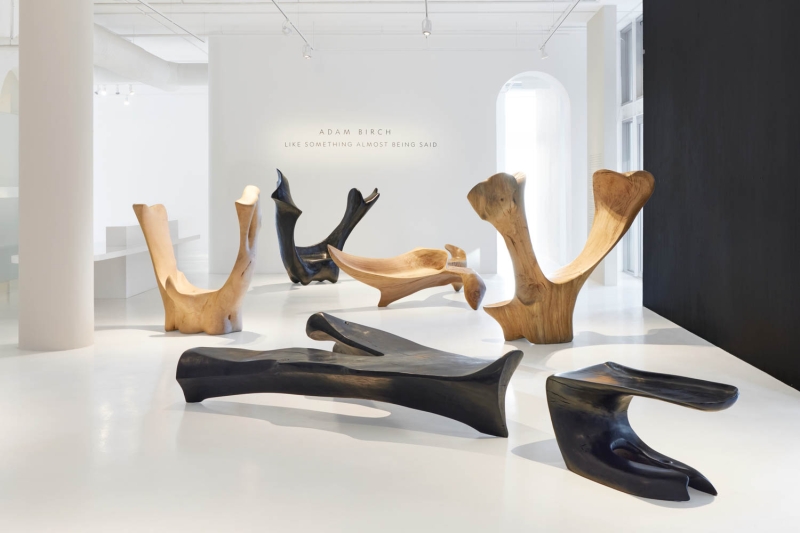Contents
- 1 How Sculptor Adam Birch Is Moved By Texture + Nature
- 1.1 Interior Design: What shaped your career as a sculptor?
- 1.2 ID: Describe your educational and family background and how that shaped your career.
- 1.3 ID: You were an arborist and forester for decades. How did you begin and what was work like as an arborist?
- 1.4 ID: What inspired your new exhibition at the Southern Guild?
- 1.5 ID: Does “Like Something Almost Being Said” has a way to explain the language of trees and how we could communicate our feelings to them?
- 1.6 ID: Your work plays with variant forms, most especially curves that could be a joint of pairs. Do the shapes and forms represent animals, or is it for an aesthetic purpose?
- 1.7 ID: In terms of materials, how do you determine whether a wood is ready to be used, and are you open to exploring with other materials aside from woods, such as clay, paper or metals?
- 1.8 ID: As an arborist, you must care deeply about trees. Are you concerned about cutting down trees to also create works?
- 1.9 ID: What is it like working in your open-air Cape Town workshop, and what was your routine like creating the pieces that are currently being exhibited?
- 1.10 ID: How do you want viewers to interpret your works and exhibitions?
South African sculptor Adam Birch is fascinated by trees, and its a testament in his career over the past two decades: First as an arborist, when he studied trees and knew their languages, and now as a sculptor, where he spends his days making art in his open-air Cape Town workshop, paying homage to the life of different species. Birch’s oeuvre as a sculptor is impressive, usually moved by his love for texture and shape; his work possesses a very rare form that mostly appears curvy, multi-dimensional and textured. Though the sights of his sculptures could be heavily misinterpreted by the viewer’s gaze, Birch maintains that his inspirational forms come from “bones and driftwood that washes up on the ocean shore.” However, he’s also very intentional about functionality and wants everyone to feel utmost comfort with his work.
The sculptor’s most recent exhibition titled “Like Something Almost Being Said,” which just finished its run at the Southern Guild Cape Town, discusses the language of trees. Birch references Philip Larkin’s 1967 poem The Trees, exploring what rebirth could mean for a dead tree, and how it could transcend and become something artistic and important. In this body of work, Birch employs his signature fork-shaped form, but also adds extra dimension for a more detailed feel—creating a scene that feels like a dialogue between the viewers experiencing the sculpture and the trees being sculpted.
Interior Design chats with Adam Birch about his career, work, and love for nature.
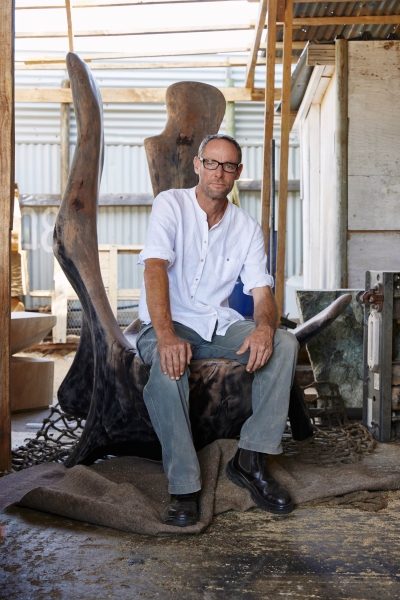
Adam Birch.
How Sculptor Adam Birch Is Moved By Texture + Nature
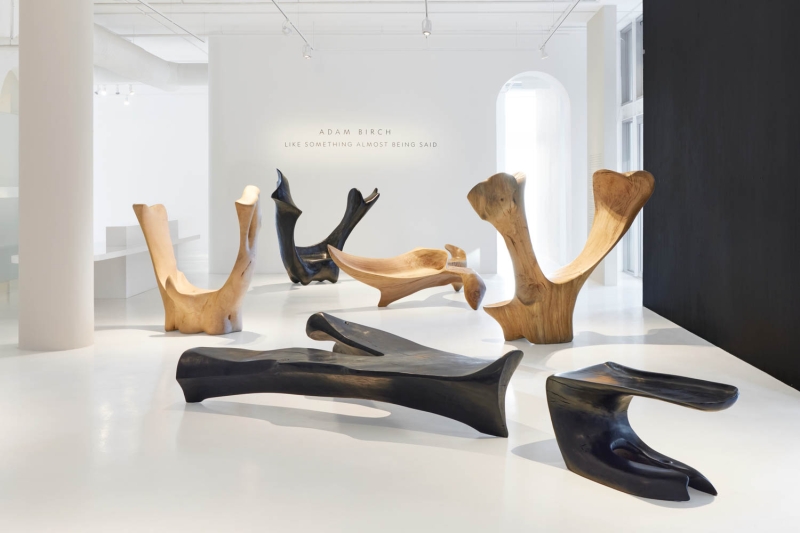
Birch’s recent exhibition “Like Something Almost Being Said” recently finished its run at the Southern Guild Capetown.
Interior Design: What shaped your career as a sculptor?
Adam Birch: When I was apprenticing as an arborist, a perfectly symmetrical fork caught my attention while pruning some trees one day. I kept it for a few years, and slowly began chiseling away at it with hand tools. That was my first tree fork sculpture, which was followed by others that I exhibited locally. Trevyn and Julian McGowan [co-founders of Southern Guild] had seen some of my work and came to visit me in my workshop in the town of Swellendam—this ended in them commissioning me to make some pieces for Anthropologie in London. They also invited me to make some works for a group exhibition of timber sculpture and collectible furniture titled “Wood Work,” at their first gallery in Woodstock, Cape Town in 2016.
ID: Describe your educational and family background and how that shaped your career.
AB: I grew up surrounded by nature—my dad managed a farm in the Cape Winelands and we had a lot of freedom as kids to immerse ourselves in the wild outdoors. At boarding school, I used to climb trees so that I could smoke—I was quite naughty as a kid—because no one ever looked up. It was the perfect place to evade the teachers’ notice. After high school, I studied fine art at the University of Stellenbosch majoring in applied graphics and photography, but I was always envious of the sculpture students, and I was drawn to the three-dimensional medium from early on. I was privileged to learn from so many excellent professors who were practicing artists themselves and who emphasized the importance of doing things over and over again to improve and to refine my technique. The same thing applies to working with wood—I’m constantly pushing the possibilities of what the timber can cope with. In the beginning, my work was more determined by the tree’s existing lines and inherent shape, but over the years I’ve been able to flex my skills and find new ways of working with the grain to find more sculptural forms.
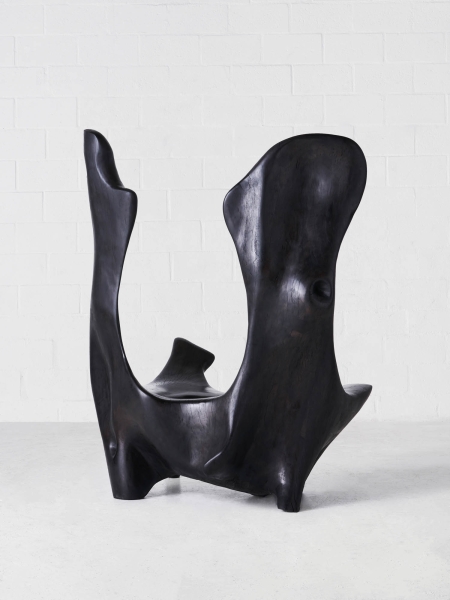
Boudicca, 2023.
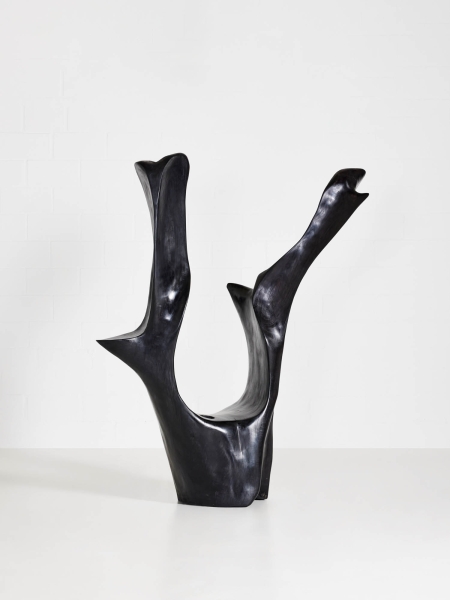
Bad Bambie, 2024.
ID: You were an arborist and forester for decades. How did you begin and what was work like as an arborist?
AB: Just after I graduated from university, I saw an ad for a tree climber and thought that would be a good way to earn some money. When I started my apprenticeship, I was told by my boss that I wouldn’t last six months—he made me drag and load branches for the first month—so I lasted seven, just to prove him wrong and then quit! I worked at a woodworking studio in Stellenbosch afterwards, designing furniture and various functional fittings. I started my own tree-felling company a couple years later. Honestly, it was terrifying initially—you are working with dangerous tools and at such great heights. You get used to it over time though; in fact, I would say I get an adrenaline rush from it now.
ID: What inspired your new exhibition at the Southern Guild?
AB: With this body of work, I was primarily concerned with pushing the boundaries of what the timber can do and handle. I’m continuing to explore some of the same shapes while working harder to tease out more flamboyant and expressive forms. Swan, for instance, is a kind of elongated love-seat, formed by scooping out two sections of a continuous piece of wood, while keeping a sort of backrest between them right at the point where the tree splits into two. I have played with the piece’s profile to take into consideration the full 360-degree experience—from one angle it looks like an elegant, slightly upturned slipper; from the other side, it’s all swirling shapes that seem to wrap around the human figure. The movement is echoed by the incredible marbled patterns of the grain in this piece of wood.
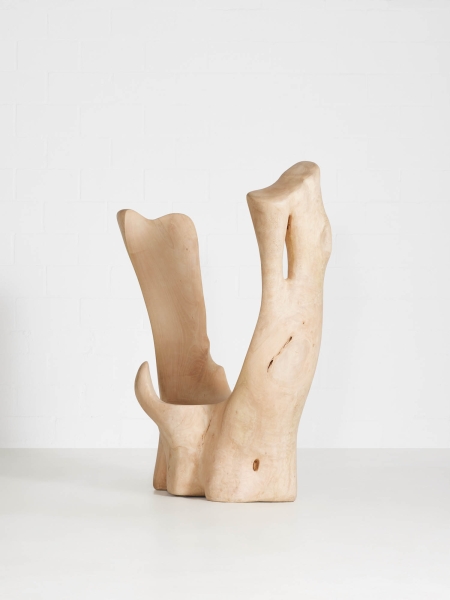
McClellan, 2024.
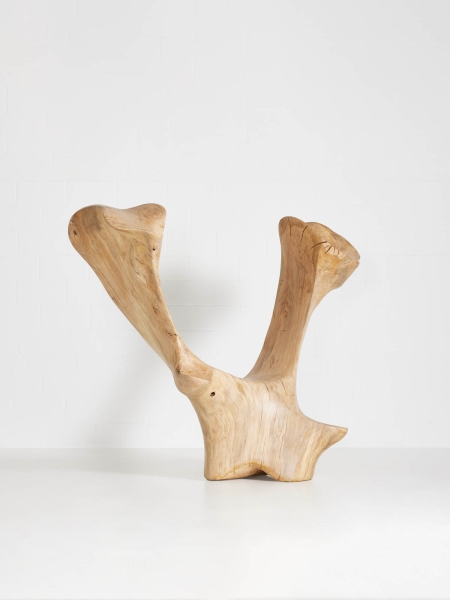
Sacrum, 2024.
ID: Does “Like Something Almost Being Said” has a way to explain the language of trees and how we could communicate our feelings to them?
AB: I sometimes find myself wanting to say sorry to a tree before cutting it down, even though chances are that it is already dead. I feel overwhelming respect for these giants, especially during the process of carving the felled tree into smaller pieces. Timber is the only material that can withstand the forces it has to endure: snow, wind, rain. If you had to cast a tree in another material—metal or plastic—nothing could withstand the force it endures with the same elegance and lightness. The leaves on a large gum tree can collectively weigh up to a tonne just on their own. I also feel incredible humility and wonder: no two pieces of wood are ever the same. Each piece has the potential to teach a new lesson. You think you’re going to do one thing, but the wood decides something else.
ID: Your work plays with variant forms, most especially curves that could be a joint of pairs. Do the shapes and forms represent animals, or is it for an aesthetic purpose?
AB: I’m not imagining animals or any particularly figurative shapes when I’m carving the wood. If anything, the shapes remind me of bones and driftwood that wash up on the ocean shore. I like the gentle shapes and smooth texture of things worn away over time, like the rope on a ship mast, oars on the gunnels of a boat, or two branches that rub against each other. When choosing my shapes, I have to take functionality into account as well, of course. The piece can’t fall over, which is why I often use a three-footed design. People need to sit on them. Kids need to climb on them.
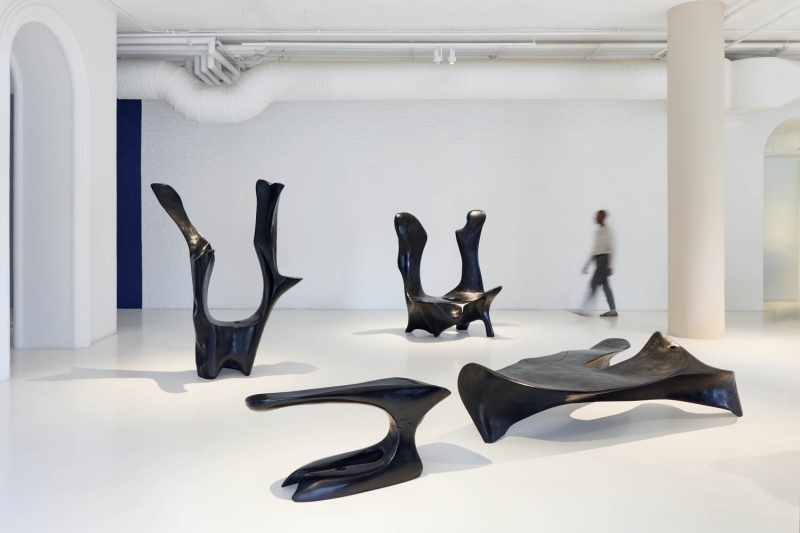
Birch’s organic pieces invite movement—and play.
ID: In terms of materials, how do you determine whether a wood is ready to be used, and are you open to exploring with other materials aside from woods, such as clay, paper or metals?
AB: I have incorporated copper before and am keen to try concrete or terrazzo, but wood is still the primary material. I let the wood stand for a couple of years—for as long as it can. Often you think a piece is dry, but it turns out not to be. You have no guarantees when you start working with it; you just hope for the best. I’m a bit of a hoarder when it comes to wood. I have a few pieces stashed here, there and everywhere, but mostly at my outdoor workshop.
ID: As an arborist, you must care deeply about trees. Are you concerned about cutting down trees to also create works?
AB: I never cut a tree down to make a sculpture. As an arborist, I only fell alien trees or trees that are diseased or already dead. I think I’m doing my bit by removing the alien species. For example, gum trees in South Africa are very invasive and in Cape Town in particular, they pose environmental threats, because they are highly combustible and remove a lot of water from the water table.
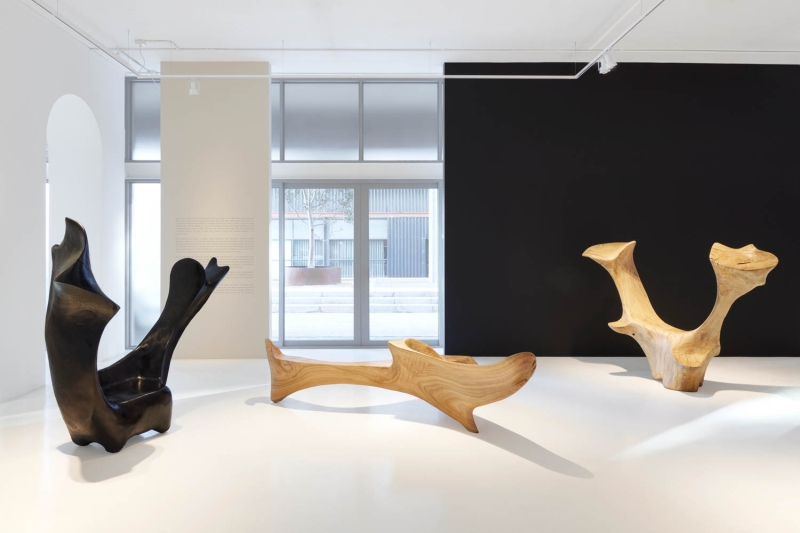
Made from felled trees, Birch stays true to his former career as an arboris when he creates new sculptures.
ID: What is it like working in your open-air Cape Town workshop, and what was your routine like creating the pieces that are currently being exhibited?
AB: I work on three or four pieces concurrently, but I’m not a routine kind of guy—my work feels a lot like chaos management. Working conditions are determined by the weather, but I roll with it and it’s mostly great fun. I have anywhere between four and nine people who work with me, and there is constant activity and noise. At any one time, there are guys chopping firewood, cleaning machines, sharpening blades, using chainsaws, and moving the pieces around depending on the sun and wind. Conditions are noisy and dusty.
ID: How do you want viewers to interpret your works and exhibitions?
AB: People can make their own minds up and find their own way of interacting with and using the pieces. What makes me very happy is how kids respond when seeing my work—they immediately start climbing all over it, swinging, jumping, and playing. It’s a joy to see.
